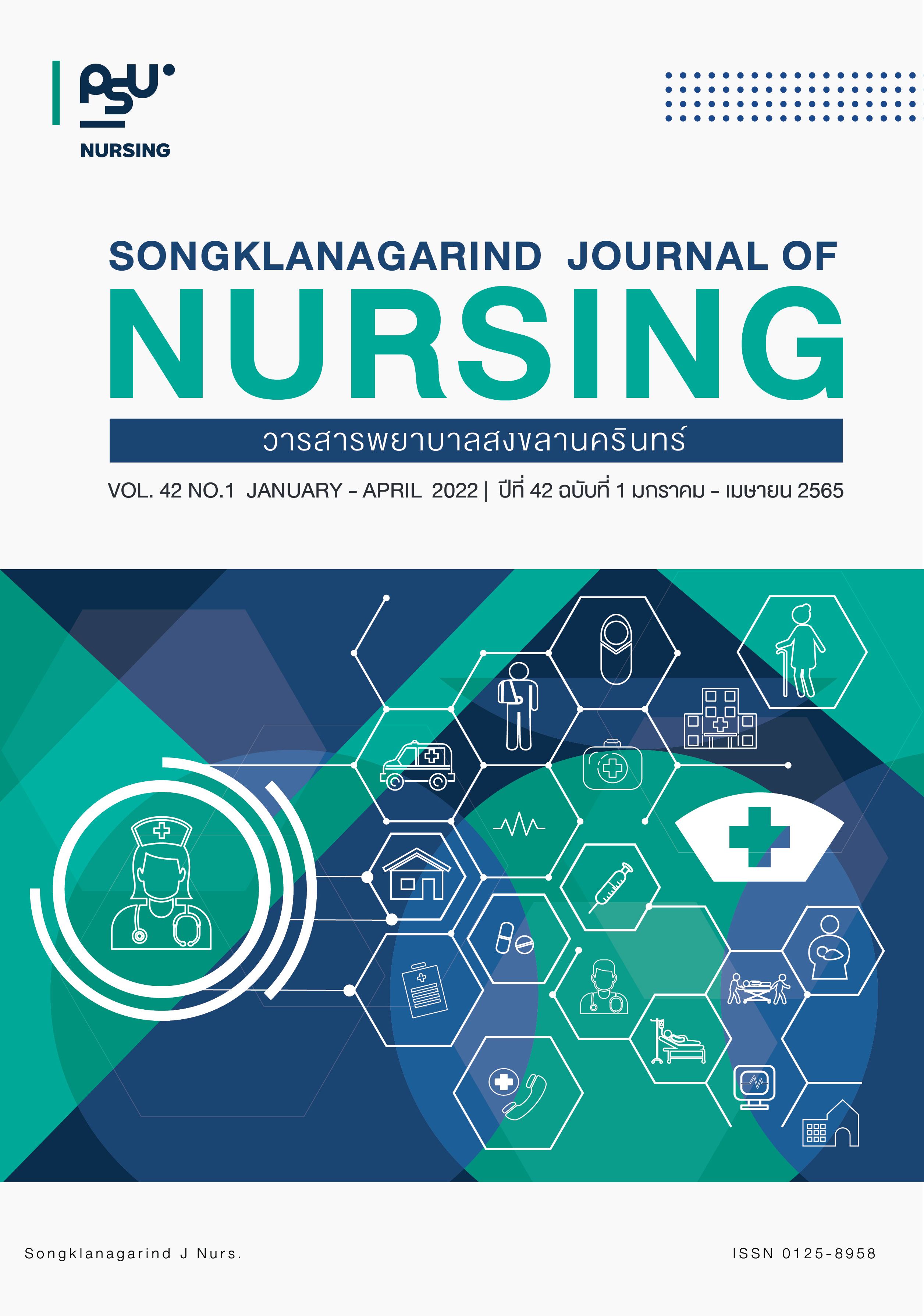ปัจจัยที่มีความสัมพันธ์กับระดับความปวดในผู้สูงอายุที่มีภาวะพึ่งพิงในชุมชน
Main Article Content
บทคัดย่อ
วัตถุประสงค์: การวิจัยนี้มีวัตถุประสงค์เพื่อศึกษาลักษณะของความปวดและปัจจัยที่มีความสัมพันธ์กับระดับความปวดในผู้สูงอายุที่มีภาวะพึ่งพิงในชุมชน วิธีการวิจัย: กลุ่มตัวอย่าง คือ ผู้สูงอายุที่มีภาวะพึ่งพิงในอำเภอเมือง จังหวัดพะเยา จำนวน 84 คน คัดเลือกตามเกณฑ์ คือ ผู้สูงอายุที่มีอายุ 60 ปีขึ้นไป ไม่มีภาวะสมองเสื่อม หรือเป็นโรคมะเร็ง มีความปวด
เรื้อรังตั้งแต่ 3 เดือนขึ้นไป เก็บข้อมูลระหว่างเดือนมีนาคม-ธันวาคม 2562 โดยใช้แบบประเมินความปวดของแมคกิลล์แบบย่อฉบับภาษาไทย แบบประเมินความสามารถในการปฏิบัติกิจวัตรประจำวัน และแบบประเมินภาวะซึมเศร้า วิเคราะห์ข้อมูลด้วยสถิติเชิงบรรยาย สถิติไคสแควร์ การทดสอบของฟิชเชอร์ และสัมประสิทธิ์สหสัมพันธ์ของสเปียร์แมน ผลการศึกษา: พบว่ากลุ่มตัวอย่างส่วนใหญ่เป็นเพศหญิง ร้อยละ 67.90 อายุเฉลี่ย 79.67 ปี (SD = 9.28) ลักษณะของความปวดมีตำแหน่งความปวดที่หนึ่งและสองตำแหน่งมากที่สุด (41.67%) มีการบรรยายลักษณะของความปวดด้านความรู้สึกสูงสุด คือ ปวดตุ๊บๆ (47.60%) และด้านอารมณ์ คือ รู้สึกไม่สบายมากที่สุด (52.40%) ส่วนใหญ่มีความปวดในปัจจุบันในระดับปวดพอรำคาญ (31.00%) มีความปวดโดยเฉลี่ยในระดับปานกลาง ( = 5.21, SD = 2.02) ปัจจัยการมีโรคประจำตัวและภาวะซึมเศร้ามีความสัมพันธ์ทางบวกกับระดับความปวด (Fisher’s exact = 0.016, p < 0.05, r = 0.48, p < 0.01 ตามลำดับ) และระดับความสามารถในการปฏิบัติกิจวัตรประจำวันมีความสัมพันธ์ทางลบกับระดับความปวด (r = -0.52, p < 0.01) สรุป: ทีมสุขภาพควรมีการประเมินความปวดในผู้สูงอายุที่มีภาวะพึ่งพิงในชุมชนอย่างต่อเนื่อง และให้การจัดการความปวดอย่างมีประสิทธิภาพ
Article Details

อนุญาตภายใต้เงื่อนไข Creative Commons Attribution-NonCommercial-NoDerivatives 4.0 International License.
เอกสารอ้างอิง
Ruangritchankul S, Krairit O. Chronic pain assessment in the elderly. Rama Med J. 2018; 41(3): 92-9. doi: https://doi.org/10.14456/rmj.2018.24. Thai.
Otones RP, García PE, Pedraz MA. Chronic pain and frailty in community-dwelling older adults: A systematic review. Pain Manag Nurs. 2019; 20(4): 309-15. doi: 10.1016/j.pmn.2019.01.003.
Brown ST, Kirkpatrick MK, Swanson MS, et al. Pain experience of the elderly. Pain Manag Nurs. 2011; 12(4): 190-96. doi: 10.1016/j.pmn.2010.05.004.
Makino K, Lee S, Bae S, et al. Pain characteristics and incidence of functional disability among communitydwelling older adults. PLoS One. 2019; 14(4): e0215467. doi: 10.1371/journal.pone.0215467.
Si H, Wang C, Jin Y, et al. Prevalence, factors, and health impacts of chronic pain among community-dwelling older adults in China. Pain Manag Nurs. 2019; 20(4): 365-72. doi: 10.1016/j.pmn.2019.01.006.
Thakral M, Shi L, Foust JB, et al. Persistence of pain quality in community-dwelling older adults with chronic non-cancer pain. Geriatr Nurs. 2018; 39(4): 450-6. doi: 10.1016/j.gerinurse.2018.01.001.
Treede RD, Rief W, Barke A, et al. Chronic pain as a symptom or a disease: The IASP Classification of chronic pain for the International classification of diseases (ICD-11). Pain. 2019; 160(1): 19-27. doi: 10.1097/j.pain.0000000000001384.
Pitantananukune P, Surit P. Chronic pain management of older persons living in a community. Journal of Nursing and Health Care. 2011; 29(4): 58-68. Thai.
Kitisomprayoonkul W, Klaphajone J, Kovindha A. Thai short-form McGill pain questionnaire. J Med Assoc Thai. 2006; 89(6): 846-53. Thai.
Bicket MC, Mao J. Chronic pain in older adults. Anesthesiology Clinics. 2015; 33(3): 577-90. doi: 10.1016/j.anclin.2015.05.011.
Guedes LPCM, Oliveira MLCd, Carvalho GdA. Deleterious effects of prolonged bed rest on the body systems of the elderly-a review. Revista Brasileira de Geriatria e Gerontologia. 2018; 21(4): 499-506. doi: 10.1590/1981-22562018021.170167.
Wang XX, Lin WQ, Chen XJ, et al. Multimorbidity associated with functional independence among community-dwelling older people: A cross-sectional study in Southern China. Health Qual Life Outcomes. 2017; 15: 73. doi: 10.1186/s12955-017-0635-7.
Foroughan M, Shahboulaghi FM, Jafari Z, et al. Pain characteristics of older residents in Iranian nursing homes. East Mediterr Health J. 2019; 25(3): 205-12. doi: 10.26719/emhj.18.045.
Ho LYW. A concept analysis of coping with chronic pain in older adults. Pain Manag Nurs. 2019; 20(6): 563-71. doi: 10.1016/j.pmn.2019.03.002.
Mallon T, Ernst A, Brettschneider C, et al. Prevalence of pain and its associated factors among the oldest-olds in different care settings-results of the AgeQualiDe study. BMC Fam Pract. 2018; 19: 85. doi: 10.1186/s12875-018-0768-8.
Choi NG, Snow AL, Kunik ME. Pain severity, interference, and prescription analgesic use among depressed, low-income homebound older adults. Aging Ment Health. 2016(8); 20: 804-13. doi: 10.1080/13607863.2015.1037244.
Bunthan W, Chumpathat N, Namjuntra R, et al. Relationship among pain, stiffness, function of knee joint and balance in community-dwelling elderly people with knee osteoarthritis at Bangsaothong Municipal District, Bangsaothong District Samutprakarn Province. HCU Journal. 2016; 19(38): 1-12. Thai.
Leularb K, Choowattanapakorn T. Effects of information-motivation-behavioral skill program on the severity of knee osteoarthritis and body weight on overweight older persons with knee osteoarthritis. Kuakarun Journal of Nursing. 2016; 23(2): 143-64. Thai.
Melzack R, Wall PD. Pain mechanisms: A new theory. Science. 1965; 150(3699): 971-9. doi: 10.1126/science.150.3699.971.
Vorapongsathorn T, Vorapongsathorn S. Sample size calculation for research using G*Power. Thailand Journal of Health Promotion and Environmental Health. 2018; 41: 11-21. Thai.
Nimmaanrat S, Tipchatyotin S. Measuring pain intensity in older patients. PSU Medical Journal. 2021; 1(2): 77-81. doi: https://doi.org/10.31584/psumj.2021247735. Thai.
Jitapunkul S, Kamolrattnankul P. Disability among the elderly living in Klong Toey Slum. J Med Assoc Thai. 1994; 77(5): 231-8. Thai.
Lotrakul M, Sumrithe S, Srikaew R. Reliability and validity of the Thai version of the PHQ-9. BMC Psychiatry 2008; 8: 46. doi: 10.1186/1471-244X-8-46.
Vibulchai N, Srikeaw S, Menasantiruk A, et al. Pain assessment of diabetic neuropathy among diabetic patients. SCNJ. 2017; 4(Suppl): 292-304. Thai.
Sharpe L, McDonald S, Correia H, et al. Pain severity predicts depressive symptoms over and above individual illnesses and multimorbidity in older adults. BMC Psychiatry. 2017; 17: 166. doi: 10.1186/s12888-017-1334-y.
Prasertsri N. Pain management in the elderly. JHBCNSP. 2019; 1: 1-19. Thai.
Cáceres-Matos R, Gil-García E, Barrientos-Trigo S, et al. Consequences of chronic non-cancer pain in adulthood. scoping review. Rev Saude Publica. 2020; 54: 39. doi: 10.11606/s1518-8787.2020054001675.
Morete MC, Solano JPC, Boff MS, et al. Resilience, depression, and quality of life in elderly individuals with chronic pain followed up in an outpatient clinic in the city of Sao Paulo, Brazil. J Pain Res. 2018; 11: 2561-66. doi: 10.2147/jpr.S166625.


